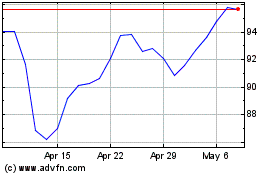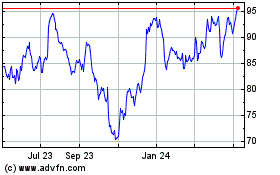By Telis Demos and Peter Rudegeair
The six biggest U.S. banks could potentially return more than
$100 billion in capital to investors over time through dividends
and share buybacks if the Trump administration succeeds in a push
to loosen bank regulation.
President Donald Trump on Friday signed a memorandum ordering a
review of the Dodd-Frank Act, the postfinancial-crisis regulatory
overhaul that has guided regulators such as the Federal Reserve.
The aim is "cutting a lot out" of those rules, President Trump said
in a meeting at the White House.
That caused bank stocks to gain ground Friday, building on sharp
increases since the presidential election. Those occurred as
investor expectations of higher interest rates, less regulation and
stronger economic growth stoked optimism.
Big banks such as J.P. Morgan Chase & Co. and Citigroup Inc.
climbed more than 3%, while the KBW Nasdaq Bank Index gained about
2.2%. That index has risen about 24% since Election Day compared
with a 7.4% gain for the S&P 500.
"Bank regulation didn't seem like priority one for the
administration, so to see these executive actions come so early is
a positive," said Jason Benowitz, senior portfolio manager at the
Roosevelt Investment Group Inc., which manages $3 billion.
As much as shareholders would welcome greater capital returns in
the short term, though, such a move would entail risks. Before the
financial crisis, for example, it was common for large banks to
spend more on dividends and stock repurchases than they earned in
annual profit. That left big banks including Citigroup poorly
positioned for financial tumult, leading it and others to be bailed
out by the government.
It isn't clear exactly what regulatory measures Mr. Trump's push
could eliminate. But one area investors are looking at is billions
of dollars of capital that banks have been forced to hold as a
buffer against future financial crises.
Bankers have argued that those buffers are in excess of what
they need to absorb losses. And some investors have come to regard
this as trapped capital since the banks' ability to return funds to
shareholders is restricted by the Fed through annual "stress
tests." That has led many lenders to hold more capital.
The top six U.S. banks have $101.57 billion in capital in excess
of what regulators require them to set aside, according to research
from RBC Capital Markets. Analysts at Morgan Stanley estimate such
capital at around $120 billion across 18 of the largest banks.
Citigroup has the most excess capital at around $27 billion,
according to RBC., J.P. Morgan has $20 billion, and Wells Fargo
& Co. has $16 billion.
"Regulatory relief could be a significant tailwind for the
industry in terms of capital efficiency and managing cost," said
Conor Muldoon, fundamental portfolio manager at Causeway Capital
Management LLC, which manages $44 billion globally. Citigroup is
the largest holding in the firm's Global Value fund, which invests
across sectors. The potential for it to return capital is a key
reason for the investment, Mr. Muldoon said.
Being able to release more or all of that capital would be a
boon to banks and their investors in several ways. First, banks
would likely return much of the capital through dividend increases
or higher share buybacks. The latter, by decreasing the number of
shares a bank has outstanding, helps to boost earnings per share.
That, in turn, can boost share prices.
Goldman Sachs bank analysts said the average, big U.S. bank
could boost 2018 earnings per share by 13% if all excess capital is
returned to shareholders via buybacks.
As well, reducing the amount of capital a bank holds helps to
boost returns on equity. This is a measure of bank profitability
that compares net income with common shareholder equity.
Many big banks have struggled in recent years to post returns
that exceed their theoretical cost of capital -- or how much it
costs them to raise funds -- of about 10%. This is due to the
superlow-interest-rate environment, slow revenue growth, subdued
trading activity and higher capital bases.
If banks' return on equity jumps, that would likely lead to
higher valuations for their shares.
Requirements for capital aren't explicitly laid out in the
Dodd-Frank Act, but are set by the Fed and other regulators. They
also are guided by international banking agreements.
While the Trump administration couldn't directly change these,
it could influence them, as well as the Fed's stress tests, through
its appointments to regulatory bodies. Notably, Mr. Trump is
expected to appoint a new head of bank supervision for the Fed, a
position mandated by Dodd-Frank but which went unfilled by the
Obama administration. Meanwhile, Republicans in Congress have urged
the Fed to suspend its participation in these global banking
discussions.
And the trend was already headed toward greater capital returns.
Before the election, the Fed had been forecasting that it would let
banks pay out more to investors, and banks including Citigroup have
said their aim was for substantially greater return to investors in
2017.
CLSA analyst Mike Mayo in a January report estimated that the
typical bank's payout in the form of dividends and buybacks as a
portion of earnings would go to 85% by 2019 from 65% in 2015, with
capital returned rising to $110 billion from $70 billion.
But capital returns that are a boon for shareholders could make
debt investors nervous, leading to an increase in bank funding
costs. Fitch Ratings warned Friday that banks could become riskier
with smaller capital buffers.
"Any changes in rules that reduce capital and liquidity
requirements could have negative rating implications if banks
respond to such rules with weaker capital and liquidity positions,"
said Joo-Yung Lee, head of North American financial institutions
for Fitch.
(END) Dow Jones Newswires
February 05, 2017 14:26 ET (19:26 GMT)
Copyright (c) 2017 Dow Jones & Company, Inc.
Morgan Stanley (NYSE:MS)
Historical Stock Chart
From Mar 2024 to Apr 2024

Morgan Stanley (NYSE:MS)
Historical Stock Chart
From Apr 2023 to Apr 2024
